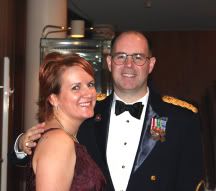One thing that has irked me recently is the spate of comments (not on this blog, but on FB) ooh'ing, and aah'ing over photography. The common theme has been, "OMG, I want that camera, it takes such good pictures!"
As as somewhat skilled photographer, this particular phrase has become my new pet peeve. Why?
Because it isn't the camera that took the picture. It's the person behind the lens. A photographer has to have a good eye, has to understand composition, and most of all, has to understand his or her camera! When a "mom with a camera" (a.k.a. MWAC) comes out and takes pictures with her big fancy camera set on automatic, she's letting the camera choose everything for her and will definitely get MOSTLY decent pictures. The camera's not always smart enough to pick the right setting, though.
That's where skill comes into play. Learning to understand what each setting on your camera is for, and knowing when best to use a particular setting, THAT'S what makes a good picture.
I can't tell you how many times I have forgotten to change the ISO on my camera, from a high (800-1200) speed (because I was shooting indoors without a flash, or outdoors, etc), to a low number (100-400 for shooting in daylight or in a lighted studio). The quality of the pictures was not great, it was grainy, and I had to run it through noiseware software to alleviate a lot of issues. Checking the settings is something I've learned to do in order to get the best photos.
Those night shots I took? They were not just point and shoot. They would have been dark, the moon would have been a blob, there would be no lightning or brightly lit clouds.
Granted, the moon shot was half luck, half skill. I had a low ISO, but enough ambient light that I could hand-hold the camera on a slower shutter speed. It was, in camera speak, ISO 200, 1/15 sec. f/5.6. That's one-fifteenth of a second. Doesn't seem like a long time to have to be steady, but add the 250 mm zoom on it, and you get camera shake. Your body is in motion even if you don't sense it!
But do you understand any of what I wrote? And how I set it? Do you know that I shot in Av (aperture priority - you choose the aperture opening, or the f-stop, the f/5.6 you see up there, and the camera sets an appropriate shutter speed) with no exposure bias?
Later on, the lightning shots were set up. Those were all shot on manual. I used a tripod because I knew I would need a very long exposure to potentially capture a bolt of lightning. My favorite shot has the following info: ISO 200, 8" (on your camera, the " mark means seconds), f/5, FL 96mm. Still a fairly low speed "film". An 8 second exposure (I touched the shutter and moved away from the camera), f/5 aperture (the lower the f number, the bigger the aperture, so the opening in my lens was letting in a LOT of light). FL is focal length. My zoom was at 96 (out of 250). I will be honest and say that I hit the shutter maybe every 15 seconds for several minutes. Because of the long exposure time (and the active thunderhead) I would capture a LOT of lightning in the clouds!
But my camera itself would not have done that for me. I had to know what it would take to set the shot up. I had to know what to do to maximize the light without sacrificing the quality of the print (high ISO=grainy=poor prints, especially larger format).
So please...do not say it's the camera! It may HELP to have a good camera, but any photographer worth her (or his) salt would be able to capture good images on low-end point-and-shoots.
Thursday, July 29, 2010
It's NOT the camera, people!
written by
Linda
at
9:08 AM
![]()
Subscribe to:
Post Comments (Atom)




6 comments:
My "good" camera has helped me become a better photographer, but not because the camera is so good. It forced me to learn what all those dials, settings and lenses do which in turn opened up a world I had never known about with snapshots.
I, too, hate it when some stranger says, "nice camera, I bet it takes great pictures." I usually respond, "no, but the photographer does!"
Yup! I have some shots I took with my Nikon point & shoot that look fantastic. It's harder to get good shots - sometimes - with a point & shoot but it's definitely doable! I just watched a video at a website where two photographers set out to prove this. They did a fashion "beauty" shoot with an iPhone. ;-) The results were really good!
Saying a good picture happens because of the camera is like saying a driver won a race because of the car. Having a fast car helps but you still need to be able to steer, brake when necessary, when it's safe to attemp a pass, and know technical stuff like wind drag. I've seen enough of your pictures to know that you do know what you're doing and you use your knowlege to get the best out of cameral you're using. I wouldn't worry too much about other people's comments. It just goes to show that YOU know your stuff and THEY obviously don't!
This is all so interesting. I am currently taking a class from Elisha Snow called, "Moving into Manual Mode." I love the exercises she's getting us to do to learn what the exposure triangle is all about. LOVE your lightning and moon shots.
Good post! This is exactly why I stick with my point & shoot! I can appreciate a great shot, but have no idea how to get one myself!
Yeah, I get it a lot too: "Oh your photos are lovely, you must have a really expensive camera". It's hard to explain to people that the camera is merely a tool. An expensive saw for example, will not make a better table! I also explain that for really good photos it's the lens that matters and not the camera body.
Post a Comment